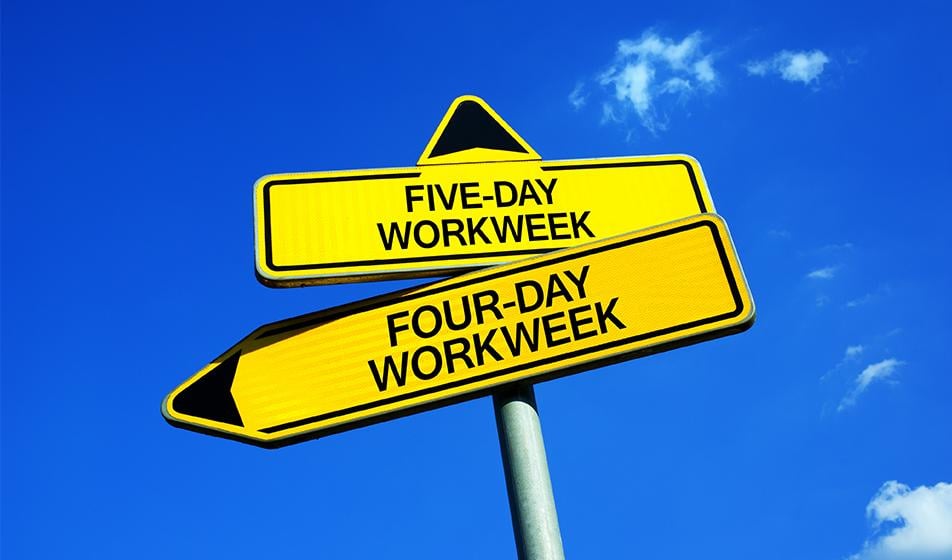We all love a three-day weekend; bank holidays are always a cause for excitement.
But what if you scrapped the traditional five-day week and made this the norm?
Would your business soar? Or would productivity take a hit?
In this article, we're unravelling:
So, what's the case for a four-day week?
There is an argument to be made that modern technology has significantly sped up the way we work, and that the five-day week is no longer necessary.
For example, cloud HR software means that long-winded spreadsheets are no longer needed and faffing around with paperwork is a thing of the past.
Whilst the five-day week used to be a great model that got the most out of its workers, it was born in an era where factory work was the norm. In a 19th-century factory, a five-day week was ideal. People would get up, go to work, do their jobs and go home. That was all there was to it.
However, with the evolution of technology and the increase in office jobs, the rule that longer hours equals more productivity doesn’t necessarily ring true. If anything, our work-life balance has taken a hit.
Trials of the four-day working week
Trials of a four-day working week in Iceland have been reportedly successful. The largest global trial of its kind saw 61 UK-based organisations take part in a six-month four-day week trial.
A huge 89% of companies who joined the trial have decided to continue with the four-day week.
100% of managers and CEOs said the four-day week had a positive or very positive impact on their employees, in a follow-up survey. 82% reported a positive impact on team wellbeing, 50% said turnover rates were reduced and 32% said it improved recruitment.
Microsoft's Japan offices also trialled it and saw a whopping 40% increase in productivity. It's also proved successful in countries like New Zealand and Sweden.
And with the four-day week pilot running in countries across the world, there's a clear sense that this change in working practice could become the norm for some organisations.
Is a four-day week right for your SME?
From cost savings to improved work-life balance, a shorter working week has potential benefits for both employers and their teams. It can offer more time to recharge, support wellbeing, and even help businesses attract and retain people. But like any shift in working patterns, it’s not one-size-fits-all. Let’s take a look at some of the key benefits and considerations.
So, how do you know if a four-day week is right for your business? To help you decide, here are some key pros & cons.
1. Reduced costs
A four-day week can cut costs for everyone.
The obvious one is that, given the office would be closed for one extra day a week, running costs would see a significant drop.
Additionally, employees would be paying less to commute and would see cut costs in expenses like lunch and coffees during the day, too.
2. Happier employees
Having a three-day weekend leaves employees with more free time and the chance to improve their work-life balance. Not many people will complain about that.
Having more time to do the things you love increases overall happiness and can help to increase loyalty to a company - it’s a win-win.
3. Fewer health issues
According to charity Mind, 1 in 6 of us experience mental health problems in any given week.
Having a longer weekend will allow people to spend more time with their friends and family and do things that they love, which will naturally lead to an improvement in wellbeing.
It'll also give them an extra lie-in each week which will help them re-charge a little more after a busy week.
4. Increase in productivity levels
Discontented staff tend to distract their co-workers. The general theory behind a shorter week is that happier, more fulfilled employees are therefore more focused on their job when actually in the workplace.
Perpetual Guardian, a New Zealand firm trialled a four-day week. The results found that 78% of employees could more effectively balance their work and home life. This was compared to 54% prior to the experiment.
5. Recruitment and retention
In the age of the millennial, being able to offer a more flexible work pattern is definitely a perk that persuades employees to stay at a company.
Research shows that 63% of businesses found it easier to attract and keep quality staff with a four-day working week. This work-life balance benefit is still a relatively rare offering and can be a great way to get the best talent through the door - and keep them engaged, too.
Disadvantages of a four-day work week
1. A four-day week doesn’t suit every business model
Unfortunately, a four-day week model doesn’t suit every business. It’s an option that is only viable for companies that can re-adapt their whole business to a new way of working.
For example, businesses in customer service, hospitality or healthcare may need to maintain coverage across the full week, which could make a shorter schedule more difficult to implement.
Adopting a different way of working is a big step, so you'll need to consider whether or not a four-day week is right for your company.
2. Longer hours and work-related stress
In reality, most employees on a four-day week will most likely be expected to work the same 40-hour weeks, but in four days instead of five. In this case, shifts might be extended to 10 hours.
Longer days could have a significant effect on your employees' stress levels and therefore their overall wellbeing and productivity. Although the theory is that more time away from work benefits an employee’s work-life balance, by working extra hard during their new ‘working week’, they may find that their work-life balance actually takes a hit.
3. Potential cost or service impact
Depending on your business, covering all working days might mean hiring more people or managing overtime pay, which can incur additional costs. And if customer expectations aren’t adjusted, there’s a risk of service delays or gaps.
How does a four-day week affect holiday entitlement?
One of the first things employees might ask is: how does a four-day working week affect my holiday entitlement?
Well, as you probably know, an employer can set their own rules on holiday and can choose to give more than the legal minimum should they want to.
If you switch to a four-day week and keep the standard 37.5 hour working week (i.e. you condense 5 days into 4), your employees' holiday allowance won't change. No sweat.
But, if you actually reduce the amount of hours your people are working each week, you'll need to re-calculate the holiday they're entitled to. And here's how you do it.
-
Leave allowance is calculated simply by multiplying the number of days worked a week by 5.6.
-
A five-day week entitles 28 days' annual leave a year.
-
So, someone working a four-day week would be entitled to: 4 days x 5.6 weeks = 22.4 days.
Are four-day weeks better and more productive?
Sophie Forrest, of Forrest HR has collated some thoughts on flexible working and how to create structures to manage blended working, below.
For further professional HR advice on these or any other topics, please see our directory of HR Partners.
Should work become more flexible?
The pandemic has proved to many businesses (that might have previously felt reluctant to allow their staff to work remotely) that a virtual workplace can be successful, prompting calls from many employees to maintain some element of remote working in future.
And it’s not just employees who are leading the calls; some notable companies have also gone on the record and stated that they’re going to push for a more flexible way of working.
One employer who’s taken this stance is PwC, who are not only calling for a change in where we work, but also in when we work. The consultancy firm has won headlines by announcing that, once restrictions are eased, their employees will be able to dictate whether they work remotely or in person, as well as the hours that they want to work.
However, not all businesses are on board with this new way of working. In February 2023 the CEO of Goldman Sachs, David Soloman, dismissed the idea that the future of working will be virtual, berating it as an ‘aberration that we’re going to correct as soon as possible’.
The stark contrast between the two companies shows that no one is really sure what the future will look like for UK employees in a post-pandemic world.
Creating structures to manage blended working
If your area of business permits it, the likelihood is that most of your staff will opt for a blend between office and home working when we return to the workplace. To ensure that this happens successfully, it’s going to be up to business owners, managers and HR professionals to put in place the necessary structures.
This will include practicalities, such as:
-
making sure that employees whose areas of business are heavily reliant upon each other overlap
-
deciding how many days per week you’re going to need your staff to be in your place of work
-
ensuring there are enough resources available (work stations, equipment etc) for the rota that you decide on.
Ultimately, with the right arrangements in place, as well as a collaborative approach between you and your staff and effective communication, you should be able to manage the return to work effectively to ensure an engaged, happy, productive workforce.
Sophie Forrest runs Forrest HR, which provides HR, training and development and health and wellbeing support to small and medium-sized businesses across the South East and London. She was named Female Entrepreneur of the Year 2020 in the SME News Southern Enterprise Awards, with Forrest HR named Best Emerging HR Consultancy Firm 2020.
The four-day week & your small business
It remains to be seen whether a four-day week will happen and become the solution to the changing 21st century workplace or not.
But, what is certain is that small businesses will have to keep an open mind.
They'll need to ensure they accommodate increasing changes in technology from a business perspective, whilst keeping the overall focus on employee health and wellbeing to maintain productivity, a healthy work-life balance and engagement.
Put your people first with Breathe. Our easy-to-use HR management software allows you to keep all your HR information in one place, including shift scheduling, holiday planning and employee records storage. Take out a free 14-day trial today.
Frequently asked questions
What are the pros of a four-day working week?
There are several reasons why more companies are exploring a shorter work week. Some of the most common benefits include:
-
Employee wellbeing – Working fewer days can support a healthier work-life balance, giving people more time to rest, see loved ones and switch off. This can lead to fewer sick days and a boost in overall well being.
-
Productivity – While it might sound counterintuitive, some trials have shown that working fewer hours over fewer days can actually improve productivity levels. When people are more focused, they often get more done.
-
Recruitment and retention – A shorter week is an increasingly attractive benefit. It can help businesses stand out when hiring and encourage existing employees to stay.
-
Sustainability and cost savings – With fewer commutes and fewer hours spent in the office, some businesses report lower operational costs. There may also be environmental benefits as energy use goes down.
It’s worth noting that results can vary depending on how a four-day working model is implemented, and what suits one organisation might not work for another.

Author: Laura Sands
Laura is a writer who enjoys getting into the detail of subjects and sharing that knowledge with snappy, interesting content. When not typing away, she enjoys walks in the woods and curling up with a good book and mug of something hot.







